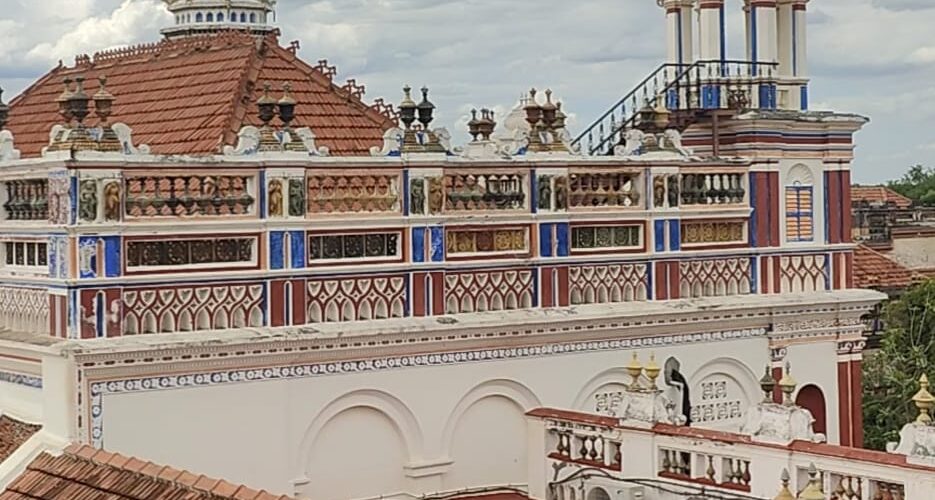Away from the hustle and bustle of the busy life, among the sun baked plains and thorny shrubland of Tamilnadu lies the sleepy, unassuming town of Karaikudi. A place where you feel that time stands still. Narrow alleyways, huge stone temples with ornate carvings and about 7500 deserted, palatial mansions make this place look like something straight out of a historical movie set.
“Chettinadu”, is a monicker like “Malenadu”. A geographical area defined by its inhabitants, culture and cuisine. It comprises the two districts of Sivagangai and Pudukottai, historically home to the Natukottai Chettiars, a prosperous but feudal community of bankers, money lenders and businessmen.

One of the turrets in a mansion
The Chettiars were originally a community which lived close to the coast of Tamilnadu, under the Chola reign. At the height of the Chola prosperity, they witnessed merchants from the far lands of Burma, Ceylon, Siam, Mauritius, Indonesia, Japan and Belgium bring their wares to court. Not restricted by the strict rules of overseas travel that applied to the then orthodox Brahmin community, they started traveling by ships to trade and barter salt, gem stones and money.
They were enamored by the rich and flamboyant buildings that were a part of medieval history wanted to replicate some of its grandeur in their hometown. Some stayed back in the strange foreign lands and started their businesses, with the intention of earning enough to fund their dreams of owning such an abode. Back home, their success translated into a rise in their ranking in the royal court of the Cholas. They were even included in the turban ceremony during the coronation of the new king.
Now for the twist in the tale. On their return from one of the voyages, the merchants were devastated to find their villages reduced to a rubble and most of their kin dead due to a tsunami. A few who survived, were living in abject poverty. This pained the merchants so much that they could not bear to live in the same towns with memories of their relatives who were no more. So, without informing the king, (who would have definitely stopped their journey), the Chettiars sought refuge from the rival Pandya king. The king was overjoyed at the prospect of having smart and business minded people as his subjects and offered a piece of land for them to settle. In what sounded like a strange request for sea faring merchants, the Chettiars asked for a piece of land far away from the turbulent shores of the Bay of Bengal.
It is this network of 73 villages, across two districts that forms the “Chettinadu” that we know today. As the times passed and memories faded, the younger generations of the Chettiars again started to brave the seas in search of trade. Their business acumen helped them flourish and their grand taste converted the treasures of their voyages into their 1500 palatial mansions (of which only 700 remain).
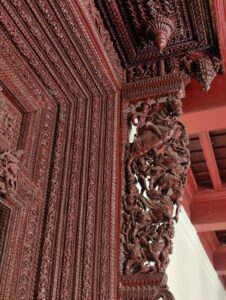
The carving on the door
The mansions were built with grand doors made of Burma teak, floors of Italian carra marble, hand painted windows, intricately carved ceilings, stained glass and mirrors from Belgium, delicate tiles from Japan, figurines from Indonesia,large halls, corridors and in some houses, upto 50 rooms! Imagine having rows of houses in multiple villages which looked like this! Mind boggling indeed!
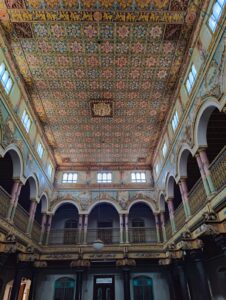
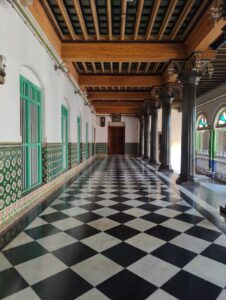
The carved ceilings, marbelled floors, wall tiles, stained glass windows and the teak wood ceilings
As the men of the families would go on long voyages leaving behind their wives and children, it probably made sense to live in large joint families of about fifty to a hundred people. The women were strong matriarchs who managed the family finances with an iron fist. Standing evidence to this are hefty, large treasury boxes which are kept in a special room in every house. And the hundreds of thousands ( not an exaggeration) of vessels and kitchen items which had to be handed out as dowries. Apparently, every house even had a room in which the dowry would be displayed!
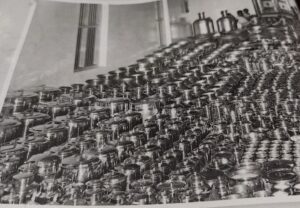
The dowry then and now….or what is left of it, in the antique shops of Karaikudi….
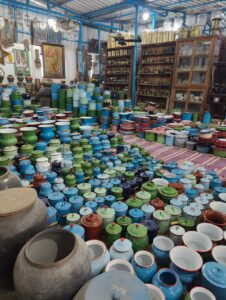
The next twist to the tale came with the formation of Independent India, which essentially took away the powers from the princely states and with it, nationalized the money lending system into banks. Suddenly bereft of their profession, the Chettiars migrated to bigger towns and cities in search of alternative occupations and education. And left their grand mansions desolate and deserted.
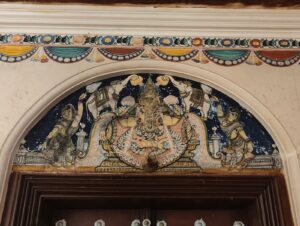
A painted window top
Now many of them lay in a mild state of ruin. A few have people living in them. Some have been converted into luxury boutique stays. And most of them are minded by care takers, waiting for their owners who visit with large families during temple festivals or family weddings.
Taking a leisurely walk through the corridors of the mansions, it is easy to imagine how life would have been in these houses a few hundred years ago. When there were people bustling about, artisans carving doors, the Chettiars going about their business of money lending on their “thinnai” – a raised platform at the front of every house, preparations for a large wedding with the zillion utensils being put to use and the palpable expectation of a father or husband returning from far shores bringing a new treasure trove of knick knacks to make the house grander than it could be.
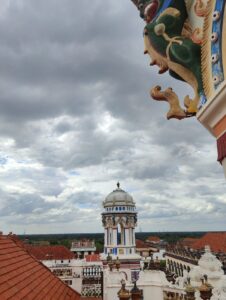
A part of our history rarely taught in schools, but oh so glorious and interesting! A must see for any history buff!

